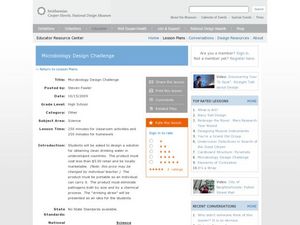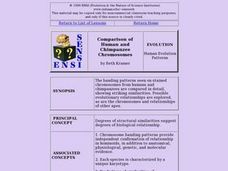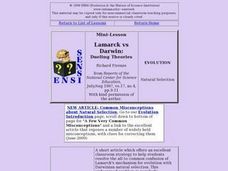Curated OER
`Great Debate' Lesson Plan for Undergraduates
Students study the Curtis- Shapley debate which highlighted the view of human place in the universe. They examine the clash of these two astronomers in a debate which took place in 1920.
Curated OER
Tracking the Wild Ones
Students apply mathematic skills to discover the extent of the concern for endangered species. Students analyze graphs and look for trends in graphed results of endangered species on a global level.
Curated OER
Threatened, Endangered & Extinct Lesson Plan
Students examine the basic needs of living organisms. In this science instructional activity, students study ecosystems and discover that organisms have basic needs that must be met.
Curated OER
What did T. rex taste like?
Students examine the three domains of life and explain that all living things share a common ancestor. In this paleontology instructional activity students are introduced to the process of illustrating evolutionary relationships.
Curated OER
Where's the Point?
Pupils examine runoff for the causes, the impact, and the solution. For this investigative lesson students construct a three dimensional model of a watershed and provide information of contaminated runoff to their audience.
Curated OER
Microbiology Design Challenge
High schoolers discover dangers to human health by researching what's in our drinking water. In this water purification instructional activity, students discuss the conditions of water in undeveloped countries and why it is unsafe to...
Curated OER
Delve Into Diseases
Fifth graders research diseases that affect people all around the world and write about their research. In this diseases lesson plan, 5th graders answer questions about vaccines, facts, differences in diseases, and more.
Curated OER
WHAT, IF ANYTHING, IS A ZEBRA?
Students read the essay, "What, If Anything, Is a Zebra?" following a teacher made reading guide. They investigate cladistics, shared derived characteristics, with further online research to enhance their study of evolution and...
Curated OER
Pseudogene Suite
Learners use Biology Workbench to explore DNA sequence data for the GULOP gene in humans, chimpanzees, orangutans, and crab-eating macaques and the beta globin gene and its pseduogene in humans, gorillas, and chimpanzees.
Curated OER
Hominoid Cranium Comparison
Students describe, measure and compare cranial casts from contemporary apes (chimpanzees and gorillas, typically), modern humans and fossil "hominids" (erect and bipedal forms evolutionarily separated from apes).
Curated OER
FOOTSTEPS IN TIME
Students measure and correlate their foot lengths and body heights, then use this data to estimate height of Laetoli hominids. They use metric measurement and graphing to determine these heights.
Curated OER
Comparison of Human and Chimpanzee Chromosomes
Students actively engage in the careful analysis of chromosome banding patterns and identify examples of inversion in homologous chromosomes.
Curated OER
A Peek at the Past: Gradualism vs. Punctuated Equilibria
Students consider two sets of simulated fossils (caminalcules) that are provided as cutouts. They arrange them on two time scales. One set produces a visual example of gradualism, the other shows punctuated equilibria.
Curated OER
2D Concept Visualization: Cell Organelles Presentation
Students create simple 2D concept driven visualizations of cells and cell organelles and organize them into an effective presentation.
Curated OER
Perception is Not Always Reality
Students view various types of illusions. Using one of the illusions, they try to determine how a scientist might explain them. They discover a t-illusion and use their own words to analyze them. In groups, they research a different...
Curated OER
The Magic Hooey Stick
Students examine the use of a "magic hooey stick". They discover the concept of illusions and how science can reveal them. They answer discussion questions to end the lesson.
Curated OER
How's Your Horoscope?
Students examine the concept of astrology. They compare their traits with those of standard astrological descriptions. They discuss their findings.
Curated OER
Crime Scene: The Case of the Missing Computer Chip
Young scholars, in teams, attempt to solve a simulated crime scene.
Curated OER
Women's Brains
Pupils experience an example of bias in science dealing with women and gender.
Curated OER
Why Cladistics?
Students explore how biological classification is intimately associated with evolution.
Curated OER
The Natural Selection of Stick-Worms
Students discuss and role-play the elements of natural selection. They use toothpicks to represent Stick-Worms and discover the mechanisms of change of traits in populations.
Curated OER
Lamarck vs Darwin: Dueling Theories
Learners, in groups, study cheetah, blind cave organisms, and naked mole rats to explain facets of evolution.
Curated OER
Island Biogeography and Evolution
Young scholars develop likely phylogenies for seven related populations of lizards living on the Canary Islands using real data. They organize charts, and record the data for geography, geology, morphology, and molecular genetics.
Curated OER
A Tall Ship and a Star to Steer Her By
Students create a water transportation device powered by wind. For this wind power lesson, students research transportation concepts after reading the poem "Sea Fever" by John Masefield. Students design the fastest sailboat they can...
Other popular searches
- Citing Sources Mla
- Citing Sources Correctly
- Citing Sources Footnotes
- Teaching Citing Sources
- Citing Sources Properly
- Citing Sources Powerpoint
- Citing Sources Mal
- Citing Sources Bibliography
- How to Citing Sources
- Citing Sources in Text
- Power Point +Citing Sources

























